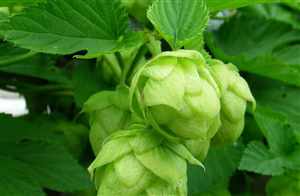Hops (Humulus lupulus)
Main Facts about Hops

Using Hops
Tea made from its fruit is used as a calming sedative to soothe tension, nerves, restlessness, sleep problems, anxiety, cramps, spasms, coughs, inflammation, boils, rheumatism. Calming effect similar to valerian. Hop flowers are much used as an infusion or can also be used to stuff pillows to sleep better. The fruit is also applied externally as a poultice to ulcers, boils, painful swellings etc, it is said to remedy painful tumours. Licorice root and hops flowers have often been used throughout history to treat hormone imbalances and just about every female problem known, giving women a sense of well being and control.Hops is a remedy for: Cold and flu, Anxiety
Caution!
Be careful when handling plant as resin and fine hairs can irritate skin.Cooking with Hops
Young leaves can be eaten in salads. A tea is made from the leaves and cones. It has a gentle calming effect. The dried flowering heads of female plants are used as a flavouring and preservative in beer.How to grow Hops
Suitable for: light (sandy), medium (loamy) and heavy (clay) soils. Suitable pH: acid, neutral and basic (alkaline) soils. It can grow in semi-shade (light woodland) or no shade. It prefers dry or moist soil and can tolerate drought.| Hibiscus |
Horse Chestnut tree
|